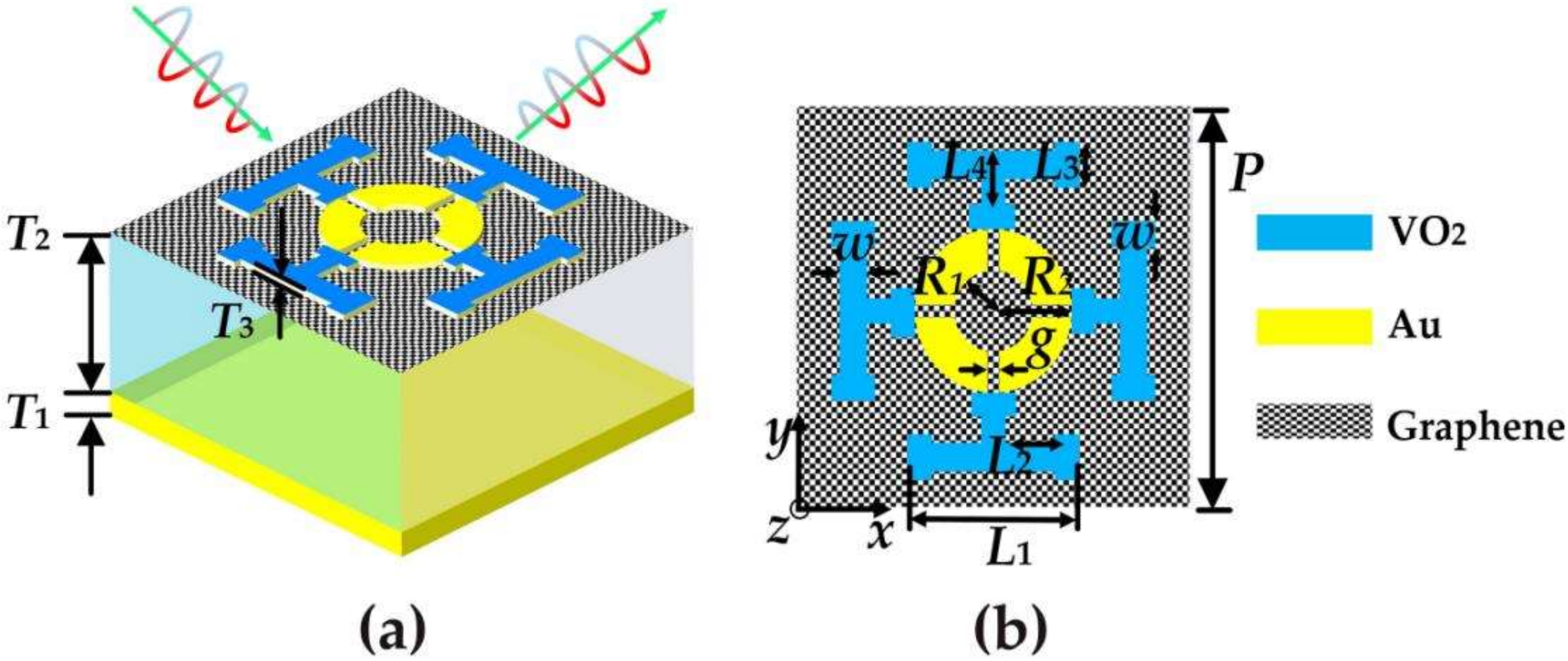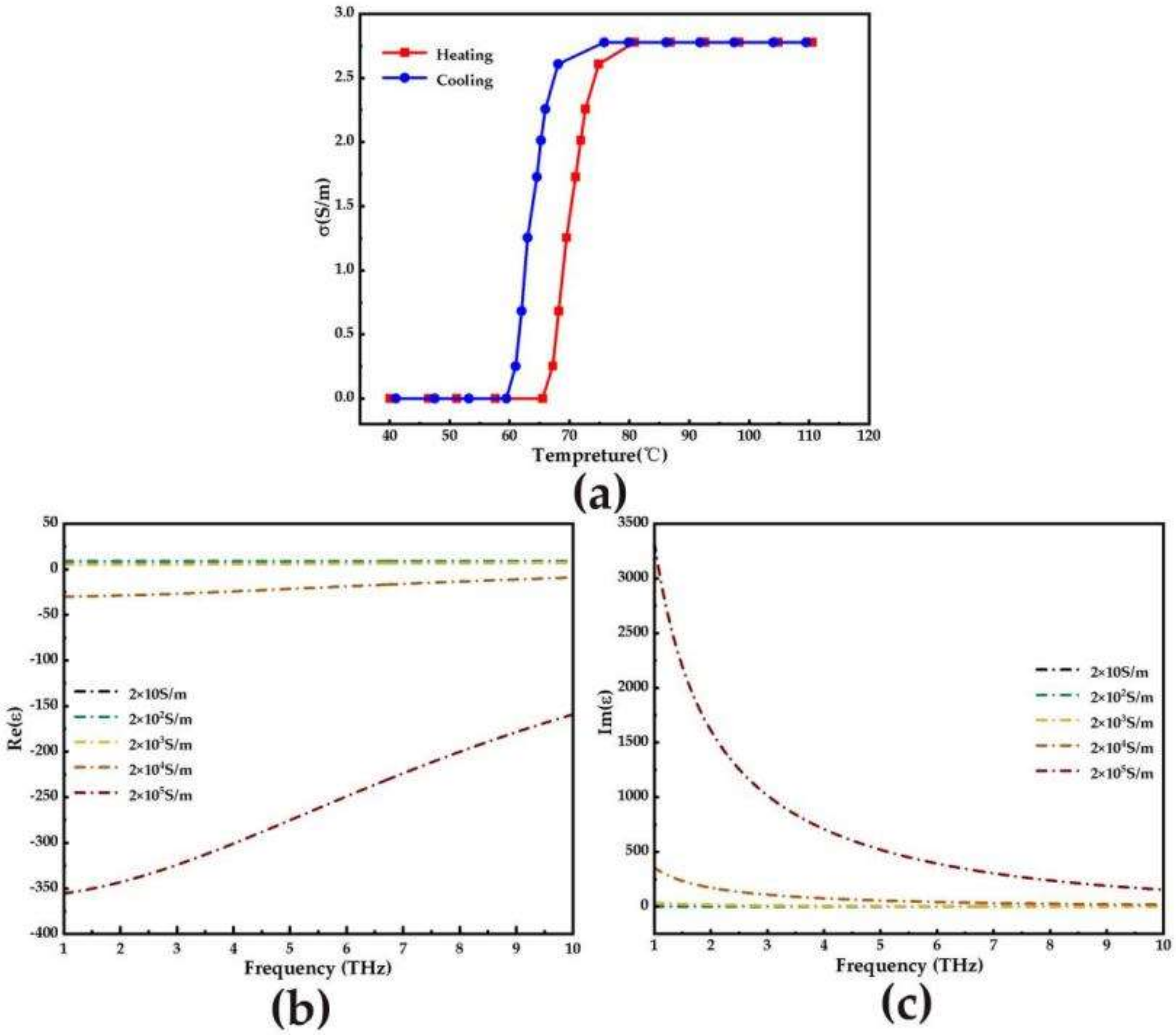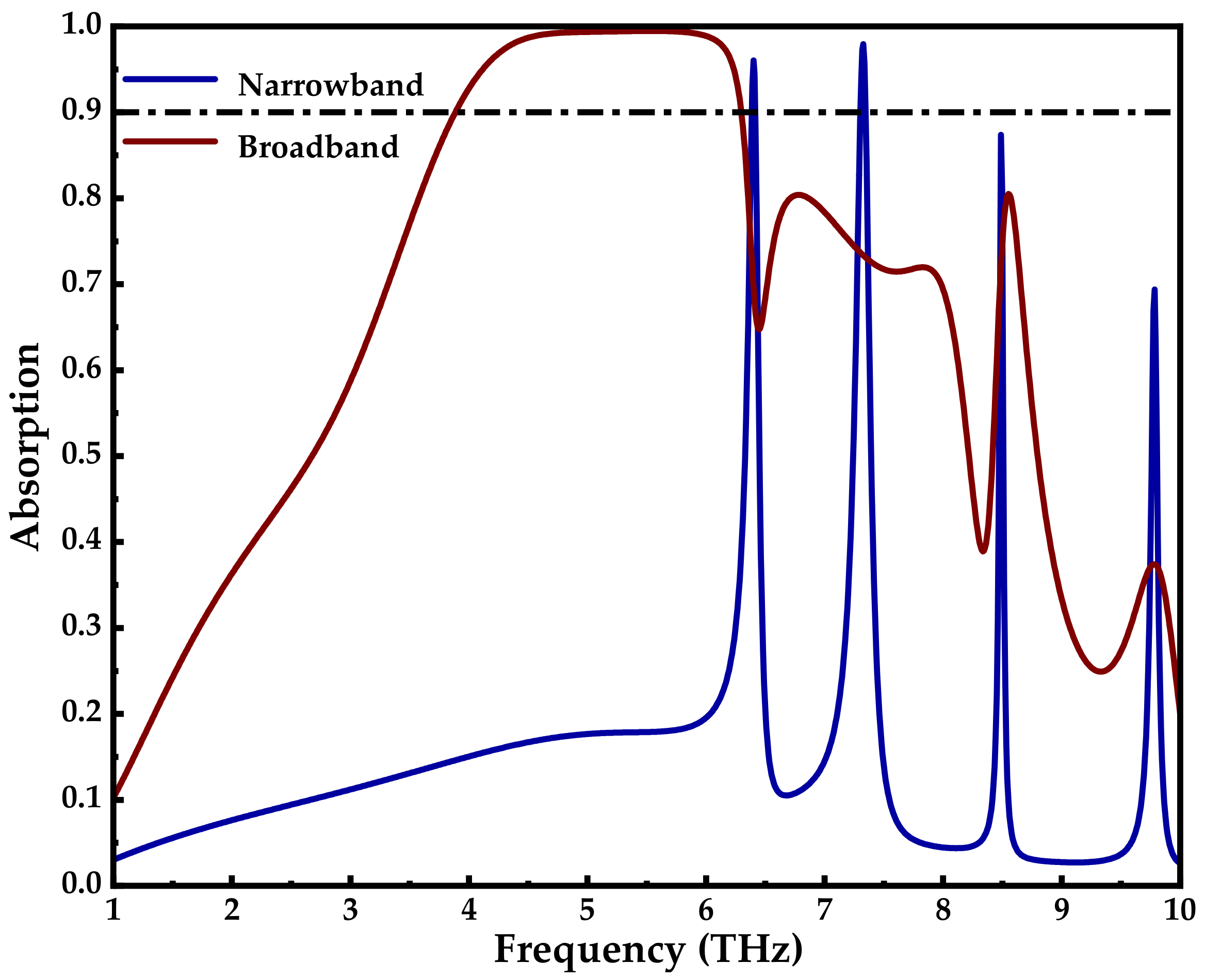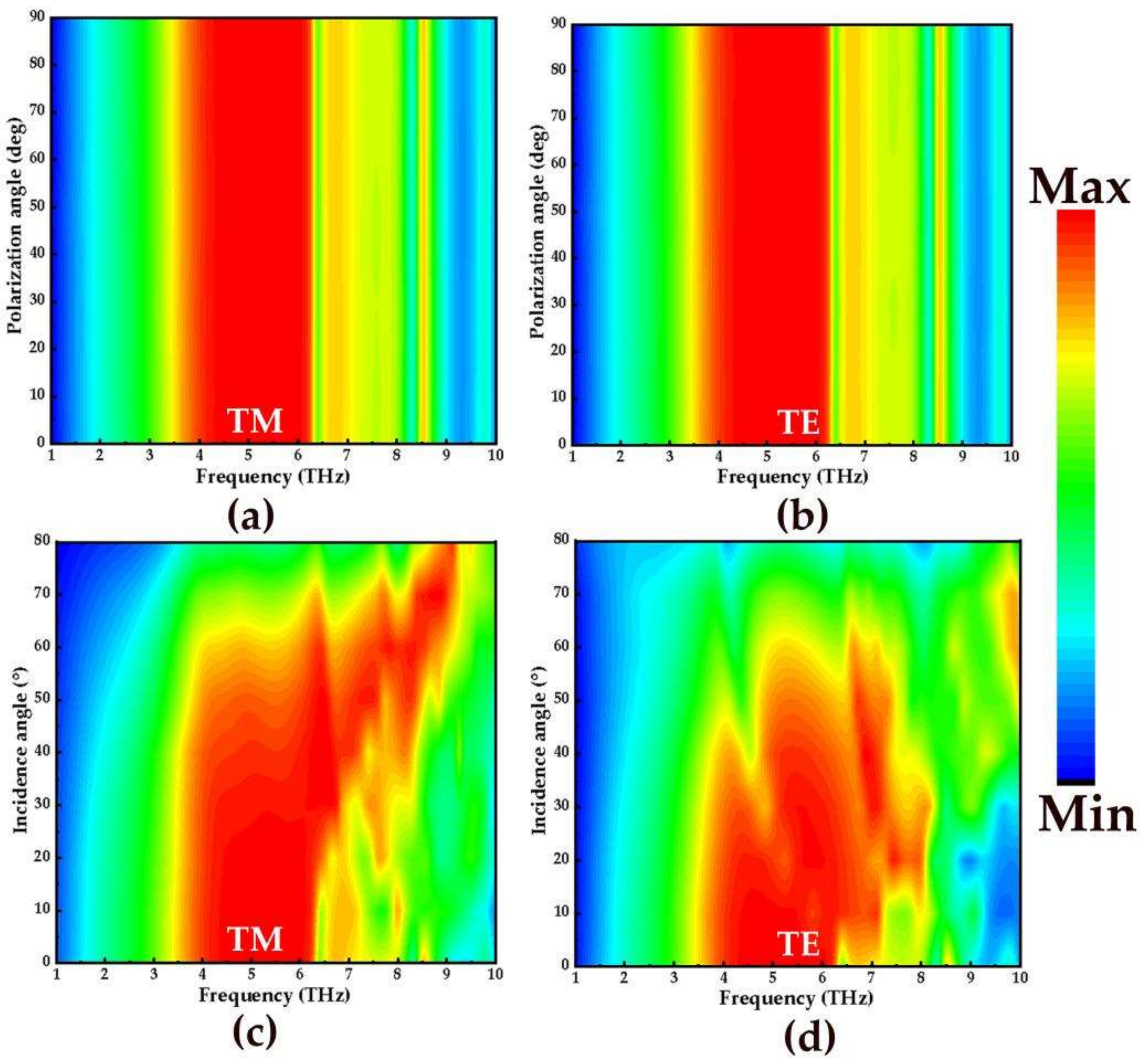Tunable Broadband-Narrowband and Dual-Broadband Terahertz Absorber Based on a Hybrid Metamaterial Vanadium Dioxide and Graphene
Abstract
1. Introduction
2. Structure Design and Method
3. Results and Discussion
4. Conclusions
Author Contributions
Funding
Data Availability Statement
Acknowledgments
Conflicts of Interest
References
- Tonouchi, M. Cutting-edge terahertz technology. Nat. Photonics 2007, 1, 97–105. [Google Scholar] [CrossRef]
- Akyildiz, I.F.; Han, C.; Nie, S. Combating the Distance Problem in the Millimeter Wave and Terahertz Frequency Bands. IEEE Commun. Mag. 2018, 56, 102–108. [Google Scholar] [CrossRef]
- Li, H.; Zheng, C.; Xu, H.; Li, J.; Song, C.; Li, J.; Wu, L.; Li, J.; Yang, F.; Zhang, Y.; et al. Diatomic terahertz metasurfaces for arbitrary-to-circular polarization conversion. Nanoscale 2022, 14, 12856–12865. [Google Scholar] [CrossRef] [PubMed]
- Zhong, R.; Yang, L.; Wu, Z.; Ma, A.; Liu, S. Ultrawideband terahertz absorber withgraphene-loaded dielectric hemi-ellipsoid. Opt. Express 2020, 28, 28773–28781. [Google Scholar] [CrossRef] [PubMed]
- Feng, H.; Xu, Z.; Kai, L.I.; Wang, M.; Yun, M. Tunable polarization-independent and angle-insensitive broadband terahertz absorber with graphene metamaterials. Opt. Express 2021, 29, 7158–7167. [Google Scholar] [CrossRef] [PubMed]
- Zamzam, P.; Rezaei, P. Renovation of dual-band to quad-band polarization-insensitive and wide incident angle perfect absorber based on the extra graphene layer. Micro Nanostruct. 2022, 168, 207261. [Google Scholar] [CrossRef]
- Wang, S.; Cai, C.; You, M.; Liu, F.; Werner, D.H. Vanadium dioxide based broadband THz metamaterial absorbers with high tunability: Simulation study. Opt. Express 2019, 27, 19436. [Google Scholar] [CrossRef]
- Zhang, Y.B.; Tan, Y.W.; Stormer, H.L.; Kim, P. Experimental observation of the quantum Hall effect and Berry’s phase in graphene. Nature 2005, 438, 201–204. [Google Scholar] [CrossRef]
- Castro Neto, A.H.; Guinea, F.; Peres, N.M.R.; Novoselov, K.S.; Geim, A.K. The electronic properties of graphene. Rev. Mod. Phys. 2009, 81, 109–162. [Google Scholar] [CrossRef]
- Ju, L.; Geng, B.; Horng, J.; Girit, C.; Martin, M.; Hao, Z.; Bechtel, H.A.; Liang, X.; Zettl, A.; Shen, Y.R.; et al. Graphene plasmonics for tunable terahertz metamaterials. Nat. Nanotechnol. 2011, 6, 630–634. [Google Scholar] [CrossRef]
- Kim, Y.; Wu, P.C.; Sokhoyan, R.; Mauser, K.; Glaudell, R.; Shirmanesh, G.K.; Atwater, H.A. Phase modulation with electrically tunable vanadium dioxide phase-change metasurfaces. Nano Lett. 2019, 19, 3961–3968. [Google Scholar] [CrossRef]
- Chu, Q.; Song, Z.; Liu, Q.H. Omnidirectional tunable terahertz analog of electromagnetically induced transparency realized by isotropic vanadium dioxide metasurfaces. Appl. Phys. Express 2018, 11, 082203. [Google Scholar] [CrossRef]
- Jeong, Y.G.; Han, S.; Rhie, J.; Kyoung, J.S.; Choi, J.W.; Park, N.; Hong, S.; Kim, B.J.; Kim, H.T.; Kim, D.S. A vanadium dioxide metamaterial disengaged from insulator-to-metal transition. Nano Lett. 2015, 15, 6318–6323. [Google Scholar] [CrossRef] [PubMed]
- Sun, P.; You, C.; Mahigir, A.; Liu, T.; Xia, F.; Kong, W.; Veronis, G.; Dowling, J.P.; Dong, L.; Yun, M. Graphene-based dual-band inde-pendently tunable infrared absorber. Nanoscale 2018, 10, 15564–15570. [Google Scholar] [CrossRef] [PubMed]
- Mou, N.L.; Sun, S.L.; Dong, H.X.; Dong, S.H.; He, Q.; Zhou, L.; Zhang, L. Hybridization-induced broadband terahertz wave absorption with graphene metasurfaces. Opt. Express 2018, 26, 11728–11736. [Google Scholar] [CrossRef]
- Hanson, H.; George, W. Dyadic Green’s functions and guided surface waves for a surface conductivity model of graphene. J. Appl. Phys 2008, 103, 064302. [Google Scholar] [CrossRef]
- Ke, S.; Wang, B.; Huang, H.; Long, H.; Wang, K.; Lu, P. Plasmonic absorption enhancement in periodic cross-shaped graphene arrays. Opt. Express 2015, 23, 8888–8900. [Google Scholar] [CrossRef]
- Li, J.; Chen, X.; Yi, Z.; Yang, H.; Tang, Y.; Yi, Y.; Yao, W.; Wang, J.; Yi, Y. Broadband solar energy absorber based on monolayer molybdenum disulfide using tungsten elliptical arrays. Mater. Today Energy 2020, 16, 100390. [Google Scholar] [CrossRef]
- Fan, F.; Hou, Y.; Jiang, Z.W.; Wang, X.H.; Chang, S.J. Terahertz modulator based on insulator-metal transition in photonic crystal waveguide. Appl. Opt 2012, 51, 4589–4596. [Google Scholar] [CrossRef]
- Tang, N.; Li, Y.; Chen, F.; Han, Z. In situ fabrication of a direct Z-scheme photocatalyst by immobilizing CdS quantum dots in the channels of graphene-hybridized and supported mesoporous titanium nanocrystals for high photocatalytic performance under visible light. RSC Adv. 2018, 8, 42233–42245. [Google Scholar] [CrossRef]
- Wang, G.; Wu, T.; Jiang, J.J.; Jia, Y.; Gao, Y.; Gao, Y.C. Switchable terahertz absorber from single broadband to triple-narrowband. Diam. Relat. Mater. 2022, 130, 109460. [Google Scholar] [CrossRef]
- Liu, Y.; Huang, R.; Ou, Z.Y. Terahertz absorber with dynamically switchable dual-broadband based on hybrid metamaterial with vanadium dioxide and graphene. Opt. Express 2021, 29, 13. [Google Scholar] [CrossRef] [PubMed]
- Badri, S.H.; Gilarlue, M.M.; Saeidnahaei, S.; Kim, J.S. Narrowband-to-broadband switchable and polarization-insensitive terahertz metasurface absorber enabled by phase-change material. J. Opt. 2022, 24, 025101. [Google Scholar] [CrossRef]
- Zhang, M.; Song, Z. Terahertz bifunctional absorber based on a graphene-spacer-vanadium dioxide-spacer-metal configuration. Opt. Express 2020, 28, 8. [Google Scholar] [CrossRef] [PubMed]
- Zhou, R.; Jiang, T.; Peng, Z.; Li, Z.; Zhang, M.; Wang, S.; Li, L.; Liang, H.; Ruan, S.; Su, H. Tunable broadband terahertz absorber based on graphene metamaterials and VO2. Opt. Mater. 2021, 114, 110915. [Google Scholar] [CrossRef]
- Wang, F.; Gao, H.; Peng, W.; Li, R.; Chu, S.; Yu, L.; Wang, Q. Bidirectional band-switchable nano-film absorber from narrowband to broadband. Opt. Express 2021, 29, 5110–5120. [Google Scholar] [CrossRef]
- Zhang, B.; Xu, K.D. Switchable and tunable bifunctional THz metamaterial absorber. Opt. Phys. 2022, 39, 152. [Google Scholar] [CrossRef]








| Fermi Level of Graphene (eV) | Phase Transition of VO2 | Absorption Bandwidth (THz) | Functionality |
|---|---|---|---|
| 0 | metallic phase | 3.85–6.32 | Low-frequency broadband absorption |
| 0 | insulating phase | 6.4, 7.32, 8.49, 9.78 | quadruple narrowband absorption |
| 0.7 | metallic phase | 6.92–8.92 | High-frequency broadband absorption |
| 0.7 | insulating phase | \ | Single fold narrowband absorption |
| Reference | Number of Layers | Absorption Bandwidth (THz) | Absorption Amplitude (%) | Tunable Range (%) | Functionality | Polarization Insensitive |
|---|---|---|---|---|---|---|
| [21] | 7 | 0.8–2.4 | 90 | 20–95 | Broadband and narrowband absorption | Yes |
| [22] | 6 | 1.05–2.35 | 90 | 5.2–90 | Dual-broadband absorption | Yes |
| [23] | 3 | 5.2–6.3 | 90 | None | Broadband and narrowband absorption | Yes |
| [24] | 5 | 1.05–2.35 | 90 | 45.5–90 | Broadband and narrowband absorption | Yes |
| [25] | 3 | 1–2.03 | 90 | 25–99.3 | Broadband absorption | No |
| This work | 4 | 3.85–6.32 | 90 | None | Broadband and narrowband absorption, Dual-broadband absorption | Yes |
| Reference | Number of Layers | Absorption Bandwidth | Absorption Amplitude (%) | Functionality | Polarization Insensitive |
|---|---|---|---|---|---|
| [21] | 7 | 0.7, 2.1, 3.9 THz | 100, 100,100 | Triple narrowband absorption | Yes |
| [26] | 6 | 771 nm | 99.90 | Single narrowband absorption | Yes |
| [27] | 6 | 0.6, 1.6, 2.8, 3.9, 5.2, 6.3, 7.4, 8.5, 9.6 THz | 90, 90, 90, 90, 90, 90, 90, 90, 90 | Nine narrowband absorption | Yes |
| This work | 4 | 6.4, 7.32, 8.49, 9.78 THz | 95.2, 97, 89.1, 73.3 | Four narrowband absorption | Yes |
Disclaimer/Publisher’s Note: The statements, opinions and data contained in all publications are solely those of the individual author(s) and contributor(s) and not of MDPI and/or the editor(s). MDPI and/or the editor(s) disclaim responsibility for any injury to people or property resulting from any ideas, methods, instructions or products referred to in the content. |
© 2023 by the authors. Licensee MDPI, Basel, Switzerland. This article is an open access article distributed under the terms and conditions of the Creative Commons Attribution (CC BY) license (https://creativecommons.org/licenses/by/4.0/).
Share and Cite
Li, J.; Liu, Y.; Chen, Y.; Chen, W.; Guo, H.; Wu, Q.; Li, M. Tunable Broadband-Narrowband and Dual-Broadband Terahertz Absorber Based on a Hybrid Metamaterial Vanadium Dioxide and Graphene. Micromachines 2023, 14, 201. https://doi.org/10.3390/mi14010201
Li J, Liu Y, Chen Y, Chen W, Guo H, Wu Q, Li M. Tunable Broadband-Narrowband and Dual-Broadband Terahertz Absorber Based on a Hybrid Metamaterial Vanadium Dioxide and Graphene. Micromachines. 2023; 14(1):201. https://doi.org/10.3390/mi14010201
Chicago/Turabian StyleLi, Jing, Yanfei Liu, Yu Chen, Wenqing Chen, Honglei Guo, Qiannan Wu, and Mengwei Li. 2023. "Tunable Broadband-Narrowband and Dual-Broadband Terahertz Absorber Based on a Hybrid Metamaterial Vanadium Dioxide and Graphene" Micromachines 14, no. 1: 201. https://doi.org/10.3390/mi14010201
APA StyleLi, J., Liu, Y., Chen, Y., Chen, W., Guo, H., Wu, Q., & Li, M. (2023). Tunable Broadband-Narrowband and Dual-Broadband Terahertz Absorber Based on a Hybrid Metamaterial Vanadium Dioxide and Graphene. Micromachines, 14(1), 201. https://doi.org/10.3390/mi14010201




